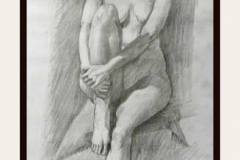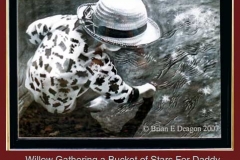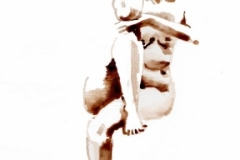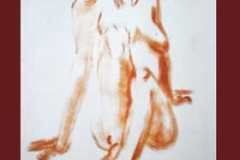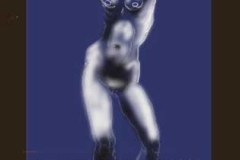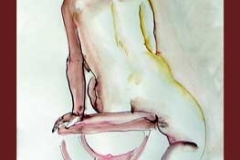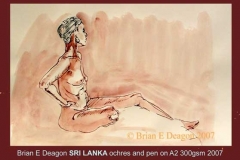Imagine drawing an apple. With a small hog fitch or flat square. Now we cannot escape the thickness of the line,but thousands of drawings ignore it. For most, the”real” edge lies somewhere obscured within the thickness. The thing is, to be conscious of its function, to decide if you are drawing inside or outside the apple. The indecision creates inaccuracies.I know.
Tag Archives: drawing
It looks just like a photo
Related Images:
Drawing is difficult
Related Images:
New York
Costa Vavagiakis gave me drawing 101.
Related Images:
ATELIER DRAWING LESSON
AN ATELIER DRAWING LESSON
Ryan Daffurn’s teaching is not what I expected. And that’s a good thing. We began a long drawing (say 10 hrs) with the admonition to get something down about the design or rhythm of the long lines of the pose in about 2 minutes.
This really surprised. I expected plumb lines to the weight bearing foot, “envelopes” within which details could be developed, and “measure, measure and measure again, after determining the eye level and viewpoint.” Apparently he wants me to work by a succession of approximations, refining and correcting as I go. Gradually I began to understand that accurate construction of design and anatomy can only begin with the whole. The same applied to light, which is constructed by mathematical logic as much as ” accidents of nature.” For example the skin tone differences between sun exposed neck and pale sun deprived chest might be noted or ignored, depending upon the conception. One things for certain, it’s not “look and put” realism. He begins with the overall conception, and is quite happy to idealise( or,if you will,”distort”) for the sake of clarity, gracefulness, dynamism or emotion in the pose.
We really need to say more about what I see as Daffurn’s idealism. It’s not the kind where everyone has a “Greek” nose and all female breasts defy gravity in their perfect cones. It goes much deeper philosophically in a Kantian or Heideggerian sense. It comes from a reverence for the constructed body, and a profound understanding of its structure in three dimensions, and the fourth dimension being potential movement in time, and all within a space of light and colour, revealing and concealing the body at the same moment.
Nothing really needs to be invented, just deeply understood. It’s a proud stance, underpinned by humility. Incidentally, the controlled art studio lighting is not mandatory, it’s just a help to the student. This is all based on a reverence for nature and the body we inhabit. More than that, it presupposes a profound belief in the intelligence of artist and audience, and the visual language they use. We intend to edify our viewer, not shock them This might not be fashionable, but it’s not “dead” as some post-structuralists might claim. To invoke beauty,hope,intelligence,diligence,persistence,structure, design etc may be idealistic and even naïve, but its not wrong..
Drawing of this kind is much more than a skill set or an arcane knowledge. It implies a moral relationship between artist and model I keep using the word “profound”. Because it is
Post script.17/5/13 Studying still life with Ryan is a revelation. I should have expected him to have the same attitude to colour and light as to form. And he does. Once again he is insistent upon the overall conception of light and colour interaction with our perceptual biology. I keep “seeing” what he expects me to ignore. I cannot paint without responding to the incident, the “flash”, the particulars.
Fighting the habits of a lifetime is starting to yield some suprises though, but the actual mechanics of eye movement and focus and the time element when shifting focus I am really struggling with. Its easy to say, “we see with the mind, not the eye ‘. All problems are solvable provided approached systematically. For example, it takes longer to mix my colours than it does to paint the picture, another dimension of the academic method no doubt!
Post script 26/8/13The advice to see and construct the perfect, or idealized sphere as a first step is critical. Only then is it possible to show the shadow shapes, the terminator between light and dark, the form shadow, the cast shadow and all the detail of representation. It is an intellectual activity to construct this ideal world, and an artist should be able to do this without “reality” in front of them. THEN the perceptual takes over, noting the “accidents of nature” nuances of colour, texture and shape.Even here, an algorythm can be developed, like in fractals, to complete the texture of the orange without copying a particular. As I work with Ryan, I am beginning to see how idealism (mind) and realism (perception) work together. Brian E Deagon 29/12/12
Related Images:
Doubt
I do not know whether arthritis in my right thumb is the problem, but certainly it is forcing me to adopt handling strategies to compensate for the loss of control. I am finding I have to spend so much energy on this that my work is slowing down and becoming boring , laboured and tentative. So much so that I am beginning to concede that I will never climb that mountain. I am simply too old.
Provided I have the wit to realize I am no longer a sherpa, I can devote my time to raising chickens. This may turn out to be even more useful ……..and fun!
And it being winter, I stuck a branch of wattle in a bottle and proceeded to paint it. It took and hour to register that I simply had no idea. “Mastering” the nude is only a beginning!
Related Images:
Drawing Conclusions
To be on the receiving end of a fine arts education in Brisbane in the 1960’s was to accept Cezanne as King, John Molvig as guru, and Ian Fairweather as eminence grise. If you wanted to exasperate your lecturers, you poured out a lot of gestures in space. There was a lot of space around ,and a lot of empty gestures. Even the life class became dominated by the “gesture drawing” , derived from Nicolaides’ book “The Natural Way To Draw” (1) It strikes me as extraordinary that half a century later, the life class rarely gets past “mark making” gestures and negative space. I dont know why they hire a model.
“Mark making ” is a shibboleth,as academic and just as silly as anything from the Beaux Artes tradition. Digging a hole in a creek bank becomes “feminising the landscape”(2) and digging holes in ourselves a “creative ” act. Some art lessons from Lucien Freud would help, but it takes a Sigmund to explain that Courbet was ” a feminist in spite of himself” (3) Still, this is an age where the smallest chicken in the window is the “large” size. That parody of text and image “disconnect” is worthy of Magritte.
It has taken “three or more generations of university educated artists” (4). a gallery system obsessed with the “white wall syndrome”. Directors who demand “30 of these” for a commercially viable show from the “stable”, a decade and more of barren works emerging from Clement Greenberg’s flat, punk angst Neo-Expressionism, the technologically driven photo-realists, Christo wrap and Beuys fat to arrive at our site specific layering of subversions of inversions of perversions. Dead ends can be a lot of fun.
Confronted by cyberspace,po__og__phy,media exploitation of violence, and an obsession with body image it is no wonder we hear the cry,”I want my body back!”. Ersatz menstrual blood and visual dissections will not restore it.
Part of the Modernist project has been the double hypocrisy of elevating the Old Masters to the status of Gods,( which they were not) and at the same time to discourage or even disparage any who tried to follow them. I am not talking here about picture restoration, appropriation in any of its forms ,or a retrograde conservatism. Spending time in Arnhem Land with aboriginal artists served to remind me that as a white ,middle aged ,educated male of European descent ,I had a culture too. The Modernist Project began to look like a bit of a hiccup. The Renaissance, as home base.
Time magazine had declared that God was Dead, and Fujiyama that History was dead. Sitting on my Derrida at a Saussure sizzle, having a beer and a Chompsky on a Baudrillard roll, I was assured it was now OK to rummage around in the museum without walls, and Foucault you!
It was ok to be eclectic,ethnic,regional,gendered,personal and even fetishistic. Robert Hughes could play Molly Meldrum. Artists could be shamans .alchemists,scavengers……….all in the same week, and before the artists 10th one man show at the age of 25!
There was hope for me yet.I had given up. In despair,for twenty years I had coached football and played basketball instead of painting. There at least,the body could be celebrated,mourned,broken,nourished; but always inhabited by a spirit that went beyond the physical. It needed no justification.
So,after ten years of drawing -I am nearly ready to try my hand at painting. Drawing is terrifying enough. With every mark-I confront my own inadequacy,and the whole of our history. My consolation sometimes lies in the fact that the gallery public have been educated to tolerate the most awful mistakes by a century of distortion and fragmentation of the body. When I begin to paint though, their instinct about their bodies will not forgive—unless some art critic declares that the small chicken is actually the biggest in the window.
David Paulson told me I would not live long enough to paint a good academic nude. I will settle for just one. Then, like the Sumi-e master, I can put down my brushes.
Brian E Deagon.1999 revised2007
1: The Natural Way to Draw: Nicolaides. 1971
2: Body. Exhibition Catalogue. Art Gallery NSW. !997 p.28
3: Courbet: Feminist In Spite Of Himself. B Faunce in Body. p95.
4:Drawing Now : B Rose 1976 Museum of Modern Art, New York 12.
